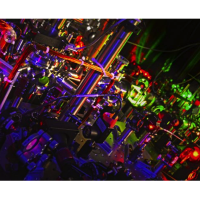News
Laser-cooling and Optical Trapping of Diatomic Molecules
Ultracold molecules have been proposed as a rich resource for many applications ranging from precision measurements and quantum metrology to quantum simulation and quantum information processing. The benefits of molecules in all these applications arise from the many internal degrees of freedom in a molecule. For example, even with the simplest two-atom diatomic molecules, one has vibration and rotation as new degrees of freedom when compared to atoms. These in turn can give rise to new features such as strong long-range dipolar interactions between molecules, a key ingredient in many proposals of quantum simulation and quantum computing.
Controlling molecules well enough to realize these applications has been a long-standing challenge. In order to have long interaction times, it is necessary to cool and trap molecules. In the past few years, there has been remarkable progress on this front. Many techniques to produce cold molecules have been developed, including techniques including cryofuges, coherent assembly from atoms, and laser cooling.
In the past year, we have developed new methods to laser-cool, trap, and detect diatomic CaF molecules at ultracold temperatures well below a micro Kelvin. We have trapped CaF molecules in a tightly-focused laser beams, and demonstrated efficient laser cooling inside these optical traps. These techniques allow us to create trapped samples of laser-cooled molecules with record densities, a first step for future experiments. Recently, we have developed a new cooling technique called Λ-enhanced gray molasses, which have led to much enhanced molecular detection. By increasing the number of photons scatted by trapped molecules by over two orders of magnitude, Λ-enhanced imaging opens the door to nondestructive detection of single trapped molecules.
In the future, building on these methods of optical trapping and detection, one could load individual ultra-cooled molecules into small, micron-scale ‘optical tweezers.’ Arrays of such tweezers could function as quantum simulators of solid materials, and offer unprecedented microscopic access to these quantum systems.
Links:
Λ-Enhanced Imaging of Molecules in an Optical Trap L. W. Cheuk, L. Anderegg, B. Augenbraun, Y. Bao, S. Burchesky, W. Ketterle, J. M. Doyle. Phys. Rev. Lett. 121, 083201 (2018). arXiv:1807.00740
Laser Cooling of Optically Trapped Molecules L. Anderegg, B. Augenbraun, Y. Bao, S. Burchesky, L. W. Cheuk, W. Ketterle, J. M. Doyle. Nature Physics 14, 890-893 (2018). arXiv:1803.04571
